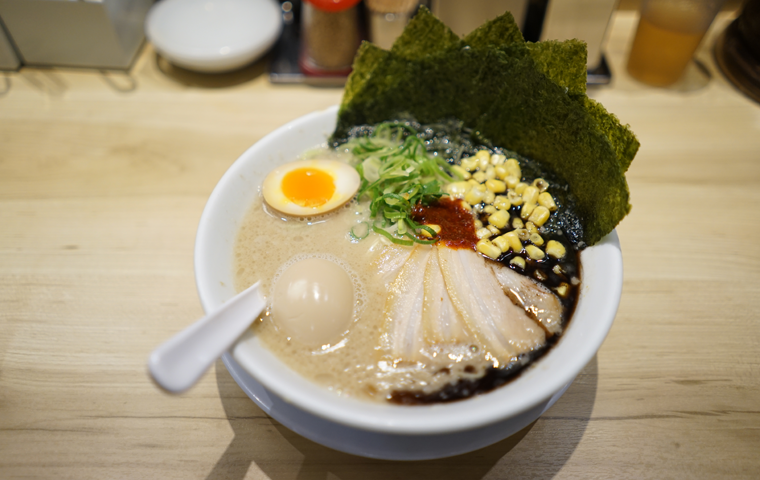Trucks Running on Ramen: How Fukuoka Invented Pork Bone Broth Biodiesel Fuel
Related Articles
“There’s a company in Kyushu that makes diesel oil from tonkotsu ramen broth and runs trucks with it.”
These days, news on oil is all about rising prices, spurred by increasing tension across the globe. Then, I heard about this company. It collects leftover tonkotsu (pork bone broth) ramen soup from restaurants to produce biodiesel fuel (BDF) without using petroleum and runs a trucking business.
On hearing this, the first thought that crossed my mind was, “Could I fill up with that diesel fuel?”

I’m a guy who loves cars. My vehicle is a Toyota Hilux with a diesel engine. It’s a pickup truck over five meters (16.4 feet) long. If this story is true, this huge body could also run on the diesel fuel made from tonkotsu soup.

Intrigued by “Ramen Soup Biofuel”
So how is the ride? Acceleration? Fuel economy? As a driver, I’m curious about these things, while I also wonder if it smells like tonkotsu ramen when driving. So, I was planning to drive all the way from my home in Chiba Prefecture to Kyushu to fill up. I phoned Nishida Logistics in Shingu-machi, Kasuya-gun, Fukuoka Prefecture to ask if I could interview them. I’m told:
“You can’t put BDF in any car, you know.”
A male employee who responded politely explained. In the Japanese system, unless it’s specified on the vehicle inspection certificate, you can’t use BDF for the car. And it wasn’t that easy with the diesel oil delivery tax involved. So, just like that, my dream of running my car with diesel fuel made from tonkotsu soup was crushed.
However, as a car fanatic, I was intrigued by the story of a trucking company producing environment-friendly fuel. With the recent boom of Sustainable Development Goals (SDGs), the very existence of cars seems to be a target of social antipathy. Even topics on electric vehicles and hydrogen fuel tend to focus on the challenges and are not entirely bright news these days.
In this situation, the transportation industry, especially does business by running vehicles. If I cover Nishida Logistics’ environmental approach, it may provide insight for Japan’s automobile society. Though I didn’t have to drive to Kyushu anymore, I decided to take a flight and visit the company.
Trucker at 16, the Self-Made Man with a 2.7 Billion Yen Business Sets Eyes on “Fuel”
Nishida Logistics is headquartered in a suburb at a 20-minute train ride from Hakata Station. Rows of large trucks filled the parking lot along the national highway, and BDF refueling pumps were installed near the office entrance.
“It began when I heard about ‘green oil fields.’”
Chairman Masumi Nishida, 74, who developed the BDF, responded to my interview. Over 15 years ago, he heard then Prime Minister Junichiro Koizumi refer to producing biofuel from corn and sugar cane as “green oil fields,” and thought, “Our trucks can’t keep on using fossil fuel,” and began BDF development.
Starting off as a truck driver at 16, Nishida is a self-made businessman who has built a comprehensive logistics company with an annual sales of 2.7 billion yen. But he had zero knowledge on chemistry and knew nothing about producing BDF.
Started at Home by Putting Leftover Tempura Oil in Plastic Bottle Cut in Half
“If it’s difficult, I’ll just do the difficult thing,” says Nishida, full of the can-do spirit. He began the self-taught BDF research in 2007.
At his home, he put used tempura cooking oil in a plastic bottle cut in half, stirred with disposable chopsticks, then put the oil in an aluminum container. He heated it on a table-top gas cooker and successfully extracted BDF. He thought, “Even I could do this,” and got immersed in BDF production alongside his management job.
He was able to produce BDF usable for trucks at a relatively early stage, but faced the problem of clogged fuel filters. Though he tried to find a solution, information on BDF was very limited at the time.
This is no surprise, since it was in 2012 that the Ministry of Agriculture, Forestry, and Fisheries (MAFF) decided on a “Biomass Commercialization Strategy” for using plants and animals as fuel. Nishida was five years ahead of this. Creating BDF from waste oil was itself a reckless challenge.
Engrossed in Research and Called “Oil Fanatic” and “Oil Nerd,” Eureka Moment with Shabu-Shabu ……
“The head of another trucking company often called me an ‘oil fanatic’ or ‘oil nerd,’ but it made me all the more determined to make high-quality BDF.”
Nishida did not give up, and rigorously continued experiments. Day in and day out, he was engrossed in BDF. In fact, this led him to a new discovery.
“I took a customer to a shabu-shabu restaurant. While watching the hot pot, I suddenly got an inspiration for controlling the BDF temperature. Or when I was drinking at home one evening, I just happened to pour beer into the BDF I was experimenting with and discovered a method for refining fuel.”
After two and a half years, Nishida finally succeeded in producing high-quality BDF. Later, he built a manufacturing plant on the company premises so he could run the company trucks on BDF derived from waste oil.
Leftover Ramen Soup Disposal Problem—“We Could Take Care of That”
In 2013, when the BDF production was getting on track, the president of a ramen chain restaurant sought his advice about the problem of discarding leftover tonkotsu ramen broth.
He said that they can’t just pour the greasy broth down the sink, and they are paying money to have it disposed. Nishida received some soup samples from the ramen restaurant, deliberated for a week, and came up with a brilliant scheme.
“If our company took in the waste oil from the ramen restaurants for free, I thought we could efficiently collect the ingredients for BDF.”
Nishida is quick to act. He began developing equipment for extracting oil and completed a device called Ramen Tonkotsu Cut-kun which separates lard from leftover ramen soup. By installing the device in the kitchen of client ramen restaurants and collecting only the lards for the ingredient, he built a system for producing BDF.
Visit by a Professor, Mention on U.S. Academic Paper—Animal Fat BDF Is Globally Rare
Generally, BDF is derived from plants such as rapeseed and soybeans, but Nishida Logistics also refines BDF from animal fat taken from pork bone broth and blends it with vegetable oil for use. There are very few cases of refining BDF from animal fat; so groundbreaking that a university professor visited the company. The production technology has been registered as a utility model, and an American university published a paper on this theme.
“The method is entirely original. The production process is all in my head, and there is no manual. The only one that exists is what my granddaughter wrote on a big sheet of paper for her summer assignment, based on my story.”
On the waiting room wall hangs the production process of the BDF, written by his granddaughter in her fifth grade. When talking about this, Nishida showed the gentle face of a grandfather.
“When I First Went to the Land Transport Bureau, They Didn’t Understand What I Was Saying”
Currently, Nishida Logistics collects waste oil for free from ramen and other restaurants, hotels, and supermarkets, and produces 36,000 liters of BDF a month at the company plant. Of about 170 company fleet, 55 percent run on BDF.
On the day of the interview, all the BDF trucks were on the road, but a company car with a diesel engine was about to fill up, so I asked if I could get a whiff of the BDF.
It does not smell of tonkotsu ramen and is clear and colorless. “The acceleration is better than standard diesel oil,” said the staff who drives the car. BDF has a higher cetane number, an indicator of the autoignition performance, than standard diesel oil, and is gentler on the engine.
I asked to see the vehicle inspection certificate. It had “Also applicable for 100% biodiesel fuel” firmly printed on the remarks column.
“The first time I went to the Land Transport Bureau to get approval for the BDF, the person at the reception had no idea what I was talking about. At the time, recognition for BDF was low, and almost no one knew you had to have it printed on the vehicle inspection certificate for refueling.”
Even today, despite so much focus on SDGs, BDF is hardly known. In fact, before I went for the interview, I asked around my acquaintances who worked at car maintenance factories, and diesel car owners like me, but they had little information on BDF.
“I’ve seen a bus being refilled with BDF……”
“If the compression ratio is the same, there seems to be no problem …….”
“Is it okay to blend with regular diesel oil?”
For the public to be free from such concerns about BDF, it may take a little more time. If it was available at general gas stations, I too want to gain approval, fill up and run my Hilux on BDF.
“With More Customers, Restaurants Will Thrive, and We Collect More Waste Oil. Then……”
The news of BDF created from tonkotsu ramen broth immediately caught media attention. Especially since a year ago, when the media began frequent coverage of SDGs, reporters came almost every day to Nishida Logistics.
Yet, Nishida does not get carried away. His biggest concern now is how the COVID pandemic has hit the dining industry. In his effort to bring in more customers, he often had the restaurants with the Ramen Tonkotsu Cut-kun installed mentioned in the radio program the company sponsored.
“With more customers, the restaurants will thrive, and we can collect more waste oil. Then, we can run more trucks on BDF and be earth friendly. It’s been 55 years since we started the trucking business, and thanks to everyone’s support, we have come this far. So now, it’s my turn to give back kindness.”
While recycling fuel, Nishida also returns the favors he has received to society. This way of thinking may be the origin of his SDGs approach.
Local Governments Requesting Waste Oil Collection; Offer from an Oil Wholesaler
One after another, local governments in Fukuoka Prefecture have contacted the company, requesting used oil from households to be collected. They also got an inquiry from an oil wholesaler who anticipates a decrease in fossil fuel usage, as well as an offer from a major taxi company.
Nishida Logistics’ main transportation business is also enjoying favorable sales. Since the company is known for its SDGs activities, their customers can appeal decarbonization efforts by just doing business together. As the company’s sincere stance in BDF production gains media coverage, new business partners have contacted them, saying, “We’d like to do business with a trucking company like yours.”
“Until When Will You Continue Working?” “Til My Dying Day”
Nishida Logistics plans to move the company headquarters to a more spacious location within the city by the end of this fiscal year. On approximately 49,500 square meters of company premises, a state-of-the-art plant will be built, which can produce up to three times the current amount of BDF.
“Right now, I really enjoy my work,” says Nishida. Though 74 years old, he skillfully uses a tablet to explain about BDF, and briskly gives directions to the employees while responding to my interview. He is an active and aggressive business manager.
At the end of the interview, I asked, “Until when will you continue working?” He instantly quipped, “Til my dying day.”
“I’d thought up to 100 years old, because if you live long enough, you may get to do more exciting business.”
Nishida Logistics’ steady advance with the BDF is likely to continue for some time.
This is a translation of the Japanese article published on Bunshun Online on March 3, 2022.




